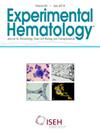CMV特异性CD4+ t细胞重构受损与停药后CMV感染有关。
IF 2.1
4区 医学
Q2 HEMATOLOGY
引用次数: 0
摘要
目的:巨细胞病毒(CMV)是一种流行的病毒,在接受同种异体造血干细胞移植(alloo - hsct)的个体中引起大量发病率和死亡率。虽然雷替莫韦的预防已经彻底改变了巨细胞病毒的管理,但雷替莫韦停药后临床显著的巨细胞病毒感染(cs-CMVi)提出了新的挑战。有效的巨细胞病毒控制在很大程度上依赖于巨细胞病毒特异性细胞介导免疫(CMI)的重建;然而,缺乏可靠的免疫生物标志物来识别赖替莫韦停药后的cs-CMVi。本研究的目的是确定不同的CMV预防方案和cs-CMVi如何影响CMV- cmi重建,以及停药后迟发性cs-CMVi的危险因素。方法:本回顾性研究分析了2021年4月至2022年12月期间接受同种异体造血干细胞移植的78例患者的数据。将患者分为先发制人治疗组(PET, n=55)和莱特莫韦治疗组(LTV, n=23)。结果:Letermovir在降低cs-CMVi累积发病率方面比先发制人治疗更有效(LTV组4.3% vs. PET组65.4%);CMV感染的严重程度与CMV- cmi反应的大小有关。经历cs-CMVi的患者比没有发生cs-CMVi的患者有更低的cmv特异性IFN-γ+CD4+ t细胞计数。巨细胞病毒患者的CMV特异性多功能CD4+ t细胞数量最低。结论:我们的研究结果建立了CMV预防、cs-CMVi和同种异体造血干细胞移植后CMV特异性t细胞反应重建之间的关联。本文章由计算机程序翻译,如有差异,请以英文原文为准。
Impaired CMV-specific CD4+ T-cell reconstitution is associated with CMV infection after letermovir cessation
Cytomegalovirus (CMV) is a prevalent virus that causes substantial morbidity and mortality in allogeneic hematopoietic stem cell transplantation (allo-HSCT). Although letermovir (LTV) prophylaxis has revolutionized CMV management, clinically significant CMV infection (cs-CMVi) after letermovir cessation presents a new challenge. Effective CMV control is heavily dependent on the reconstitution of CMV-specific cell-mediated immunity (CMI); however, there is a lack of reliable immunologic biomarkers for identifying cs-CMVi after LTV withdrawal. The aim of the present study was to determine how different CMV preventive regimens and cs-CMVi impacted CMV-CMI reconstitution and the risk factors for late-onset cs-CMVi after LTV cessation. The patients were divided into the preemptive therapy (PET, n = 55) and LTV (n = 23) groups. LTV was significantly more effective at decreasing the cumulative incidence of cs-CMVi than PET (4.3% vs. 65.4%, p < 0.01) within 100 days post-allo-HSCT. Meanwhile, after day 100, the cumulative incidence of late-onset cs-CMVi was higher in the LTV than in the PET group (26.1% vs. 7.3%, p = 0.02). We found that LTV delayed the reconstitution of CMV-specific CD8+ T cells. Patients who experienced cs-CMVi had lower CMV-specific interferon (IFN)-γ+CD4+ T-cell counts than those who did not develop cs-CMVi. Patients with CMV disease had the lowest numbers of CMV-specific polyfunctional CD4+ T cells. Polyfunctional CMV-specific CD4+ T-cell count < 2.01 cells/µL might predict late-onset cs-CMVi after LTV cessation (50.0% vs. 7.69%, p = 0.04). Our findings establish an association between CMV prophylaxis, cs-CMVi, and CMV-specific T-cell response reconstitution post-allo-HSCT.
求助全文
通过发布文献求助,成功后即可免费获取论文全文。
去求助
来源期刊

Experimental hematology
医学-血液学
CiteScore
5.30
自引率
0.00%
发文量
84
审稿时长
58 days
期刊介绍:
Experimental Hematology publishes new findings, methodologies, reviews and perspectives in all areas of hematology and immune cell formation on a monthly basis that may include Special Issues on particular topics of current interest. The overall goal is to report new insights into how normal blood cells are produced, how their production is normally regulated, mechanisms that contribute to hematological diseases and new approaches to their treatment. Specific topics may include relevant developmental and aging processes, stem cell biology, analyses of intrinsic and extrinsic regulatory mechanisms, in vitro behavior of primary cells, clonal tracking, molecular and omics analyses, metabolism, epigenetics, bioengineering approaches, studies in model organisms, novel clinical observations, transplantation biology and new therapeutic avenues.
 求助内容:
求助内容: 应助结果提醒方式:
应助结果提醒方式:


